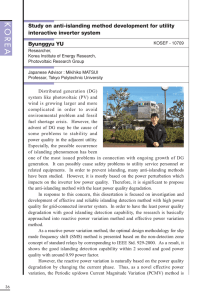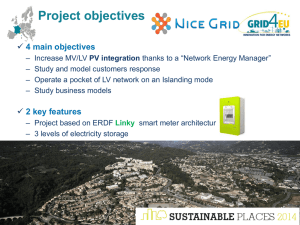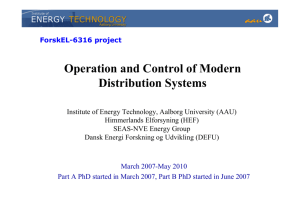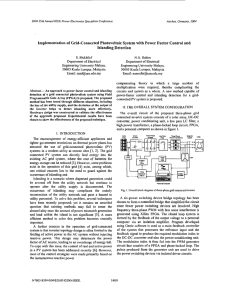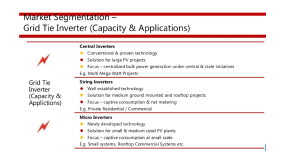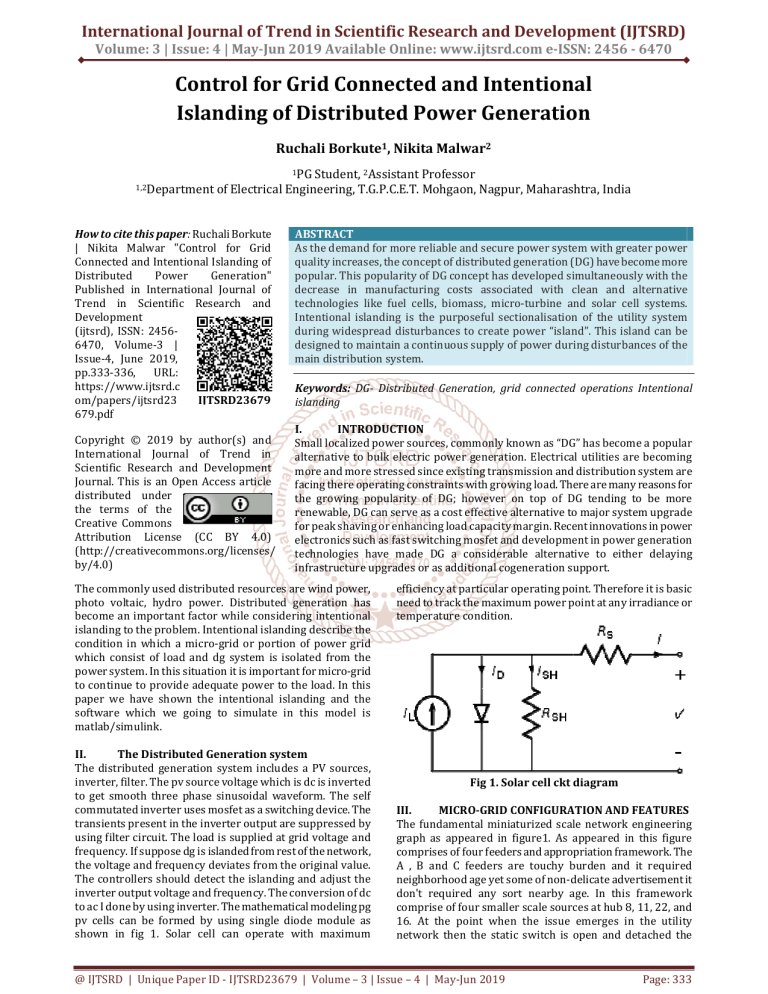
International Journal of Trend in Scientific Research and Development (IJTSRD)
Volume: 3 | Issue: 4 | May-Jun 2019 Available Online: www.ijtsrd.com e-ISSN: 2456 - 6470
Control for Grid Connected and Intentional
Islanding of Distributed Power Generation
Ruchali Borkute1, Nikita Malwar2
1PG
Student, 2Assistant Professor
1,2Department of Electrical Engineering, T.G.P.C.E.T. Mohgaon, Nagpur, Maharashtra, India
How to cite this paper: Ruchali Borkute
| Nikita Malwar "Control for Grid
Connected and Intentional Islanding of
Distributed
Power
Generation"
Published in International Journal of
Trend in Scientific Research and
Development
(ijtsrd), ISSN: 24566470, Volume-3 |
Issue-4, June 2019,
pp.333-336,
URL:
https://www.ijtsrd.c
om/papers/ijtsrd23
IJTSRD23679
679.pdf
Copyright © 2019 by author(s) and
International Journal of Trend in
Scientific Research and Development
Journal. This is an Open Access article
distributed under
the terms of the
Creative Commons
Attribution License (CC BY 4.0)
(http://creativecommons.org/licenses/
by/4.0)
ABSTRACT
As the demand for more reliable and secure power system with greater power
quality increases, the concept of distributed generation (DG) have become more
popular. This popularity of DG concept has developed simultaneously with the
decrease in manufacturing costs associated with clean and alternative
technologies like fuel cells, biomass, micro-turbine and solar cell systems.
Intentional islanding is the purposeful sectionalisation of the utility system
during widespread disturbances to create power “island”. This island can be
designed to maintain a continuous supply of power during disturbances of the
main distribution system.
Keywords: DG- Distributed Generation, grid connected operations Intentional
islanding
I.
INTRODUCTION
Small localized power sources, commonly known as “DG” has become a popular
alternative to bulk electric power generation. Electrical utilities are becoming
more and more stressed since existing transmission and distribution system are
facing there operating constraints with growing load. There are many reasons for
the growing popularity of DG; however on top of DG tending to be more
renewable, DG can serve as a cost effective alternative to major system upgrade
for peak shaving or enhancing load capacity margin. Recent innovations in power
electronics such as fast switching mosfet and development in power generation
technologies have made DG a considerable alternative to either delaying
infrastructure upgrades or as additional cogeneration support.
The commonly used distributed resources are wind power,
photo voltaic, hydro power. Distributed generation has
become an important factor while considering intentional
islanding to the problem. Intentional islanding describe the
condition in which a micro-grid or portion of power grid
which consist of load and dg system is isolated from the
power system. In this situation it is important for micro-grid
to continue to provide adequate power to the load. In this
paper we have shown the intentional islanding and the
software which we going to simulate in this model is
matlab/simulink.
II.
The Distributed Generation system
The distributed generation system includes a PV sources,
inverter, filter. The pv source voltage which is dc is inverted
to get smooth three phase sinusoidal waveform. The self
commutated inverter uses mosfet as a switching device. The
transients present in the inverter output are suppressed by
using filter circuit. The load is supplied at grid voltage and
frequency. If suppose dg is islanded from rest of the network,
the voltage and frequency deviates from the original value.
The controllers should detect the islanding and adjust the
inverter output voltage and frequency. The conversion of dc
to ac I done by using inverter. The mathematical modeling pg
pv cells can be formed by using single diode module as
shown in fig 1. Solar cell can operate with maximum
efficiency at particular operating point. Therefore it is basic
need to track the maximum power point at any irradiance or
temperature condition.
Fig 1. Solar cell ckt diagram
III.
MICRO-GRID CONFIGURATION AND FEATURES
The fundamental miniaturized scale network engineering
graph as appeared in figure1. As appeared in this figure
comprises of four feeders and appropriation framework. The
A , B and C feeders are touchy burden and it required
neighborhood age yet some of non-delicate advertisement it
don't required any sort nearby age. In this framework
comprise of four smaller scale sources at hub 8, 11, 22, and
16. At the point when the issue emerges in the utility
network then the static switch is open and detached the
@ IJTSRD | Unique Paper ID - IJTSRD23679 | Volume – 3 | Issue – 4 | May-Jun 2019
Page: 333
International Journal of Trend in Scientific Research and Development (IJTSRD) @ www.ijtsrd.com eISSN: 2456-6470
touchy burdens from the fundamental framework. At the
point when the small scale network is framework associated
control streaming the non-delicate burdens. The smaller
scale framework comprises of ace controller or focal
controller. It is controlling the task of smaller scale
framework. This framework is arranged into three classes.
disturbances. There are different methods available in the
literature to detect islanding. They are mainly local method
and remote methods. Remote methods are based on the
communication between local DG and the utility grid where
as local methods rely on monitoring parameters like voltage
and frequency at the DG sites..
V. Simulation system and discussion
As we can see from fig 2 which is a complete simulation
model of the project, the pv system consist of the pv panels
which are connected in parallel with each other. Each single
panel consist of six arrays. This panel are connected to
voltage sensors and current sensors to calculate the
generating voltage and current. Current and voltage is been
measure using current measurement and voltage
measurement. The solar panels are connected to mppt. The
mppt is been done by using the perturb and observe method.
Fig 3 shows the mppt model in simulation. The boost convert
is been made to boost the generation of the voltage.The
inverter which mainly consist of six pulse generation by
using the switching device which is mosfet. The maximum
amount of unused power is stored in the battery. The nickel
metal hydride type of battery is been used which has the
maximum capacity .The bus system is been made which has
several loads connected to it.
Fig2. Basic Micro-grid architecture
IV.
Islanding Concept
Islanding is a condition in which the DG continues to supply
power to the location even though electrical grid power is no
longer present. There are two types of islanding modes
mainly, Intentional islanding that is planned and
unintentional islanding that is unplanned. The purpose of
intentional islanding is to sectionalize the utility system in
order to create a power island during an occurrence of
Discrete,
Ts = 5e-006 s.
powergui
+v
-
+v
-
Scope
Scope1
Solar Panel
Converter
DC Link
Inverter
DC Link
BUSSYSTEM
MPPT
MPPT
+
Scope3<Current (A)>
<Voltage (V)>
m
Converter
_
Battery
Fig 2. Complete model
1
V
V Filter
Vn
-1
Pn
If DeltaP*DeltaV>0 Switch1
-CDeltaD
Pn-Pb
Vb
DeltaP*DeltaV
1
If DeltaP*DeltaV<0
2
I
I Filter
In
D State
Add
Vn-Vb
Pb
Ib
Db
Constant1
Repeating
Sequence1
1
Switch2
1
D
Constant2
Saturation
D Sample
0
Fig 3. MPPT Simulation
@ IJTSRD | Unique Paper ID - IJTSRD23679 | Volume – 3 | Issue – 4 | May-Jun 2019
Page: 334
International Journal of Trend in Scientific Research and Development (IJTSRD) @ www.ijtsrd.com eISSN: 2456-6470
V.
Simulation result
VII. Conclusion:In this paper we have develop a current and voltage control
techniques for the grid connected system and intentional
islanding has done for the operation of the system. The DG
system is synchronized with the micro grid and the main
power grid and the performance of the micro grid has been
evaluated, analyzed and determined using effective use of
MATLAB/SIMULINK. The grids connected mode with the
help of the intentional islanding can be synchronized with
the
1. Power Quality
2. Loss of main detection
3. Load shedding
References:[1] Rashad M. kamel, “Maintaining stability of standalone
Micro grid by employing electrical and mechanical fault
ride through techniques upon fixed speed wind
generation system”, Energy Conversion and
management, pp 149-161 2013.
[2] Gaurav.K.Kasal and Bhim singh, “Voltage and Frequency
Controller for an Asynchronous Generator-Based
Isolated Wind Energy Conversion System”, IEEE
Transation on Energy Conversion, Vol. 26, no. 2, June
2011.
[3] P. K. Goel, B. singh, S. S. Murthy and N. Kishore,
“Isolated Wind-Hydro Hybrid System Using Cage
Generators and Battery Storage”, IEEE Transactions on
Industrial Electronics,vol.58, no.4, April 2011.
[4] V. Rajagopal, Bhim Singh, “Design of a stae-Hexagon
Transformer based Electronic Load Controller for
isolated Pico Hydro Generating System”, third
International Conference on power Systems,
Kharagpur, pp no.153, Dec 2009.
[5] R. H. Lasseter, “Micro grids(distributed power
generation)”, IEEE Power Engineering Society Winter
Meeting,vol.01, pp.146-149, Columbus,ohio, feb 2001.
[6] F. Katiraei, M. R. Iravani and P. W. Lehn, “Micro grid
Autonomous operation During and Subsequent to
Islanding Process”, IEEE Trans. on power Delivery,
vol.20, no.1, Jan 2005.
[7] Changhee Cho, Jin-Hong Jeon, Jong-Yul Kim, Soonman
Kwon, Kyongyop Park and Sungshin Kim, “Active
Synchronizing Control Of a Microgrid”, IEEE
Transaction on power Electronics, vol.26, pp 12, Dec
2011.
[8] Irvin J. Balaguer, Qin lei, Shuitao Yang, uthane Supatti
and Fang Zheng Peng, “Control for Grid Connected and
Intentional Islanding Operation of Distributed Power
Generation”, IEEE Transaction on Industrial
Electronics, vol.58, no.1, Jan 2011.
[9] Shivkumar V Iyer, Madhu N. Belur and Mukul C.
Chandorkar, “Analysis and mitigation of voltage offsets
in multi-inverter micro grid”, IEEE Transaction on
Energy Conservation, vol. 26, no 1, March 2011.
@ IJTSRD | Unique Paper ID - IJTSRD23679 | Volume – 3 | Issue – 4 | May-Jun 2019
Page: 335
International Journal of Trend in Scientific Research and Development (IJTSRD) @ www.ijtsrd.com eISSN: 2456-6470
[10] Massucco, S,; Pitto, A, ;Silvestreo, F. A. Gas turbine
model for studies on distributed generation penetration
into distributed network, IEEE Trans. Power Syst.2011,
26, 992-999.
[15] Mohomad, H,; Mokhlis, H,; Bakar, A. H. A,; Ping, H. W. A
review on islanding operation and control for
distributed network connected with small hydro power
plant. Renew. Sustain. Energy Rev.2011, 15,3952-3962.
[11] Balaguer, L; Lei, Q.; Yang, s,; Supatti, U,; Peng, F. Z.
Control for Grid Connected and Intentional Islanding
Operation of Distributed Power Generation. IEEE
Transaction.Ind.Electron.2011, 58, 147-157.
[16] Trujillo, c.;Velasco, D.; Figueres, E,; Garcera, G. Local and
remote techniques for islanding detection in
distributed generators. In Distributed Generation; In
Tech publication;Rijeka,croatia,2010;Chapter 6.
[12] Chen, Y,; Xu, Z,; Ostergaard, J. Frequency analysis for
planned islanding operation in the Danish distributed
system-Bornholm. In Proceeding of the 43rd
International Universities Power Engineering
Conference,UPEC,Padova,Italy,1-4 September 2008;
pp.1-5.
[17] Mahat, p,; Chen, Z,; Bak-Jensen, B. Review of islanding
detection methods for distributed generation. In
Proceeding of the 3rd International Conference on
Electric Utility Deregulation and Restructuring and
power Technologies,DRPT,Nanjing,China,6-9 April
2008;pp.2743-2748.
[13] Shahabi, M,; Haghifam, M. R,; Mohamadian, M,; NabaviNiaki,s. Dynamic behaviour improvement in a
microgrid with multiple DG units using a power sharing
approach. In proceeding of the IEEE Bucharest Power
Tech,Bucharest,Romania,28 June 2009; pp.1-8.
[18] Maki, K,; Kulmala, A.; Repo, S.; Jarventausta, P. Problems
related to islanding protection of distributed
generation in distributed network. In Proceeding of the
IEEE Power Tech,Lausanne,Switzerland,1-5 july 2077;
pp.467-472.
[14] Mulhausen,J,;Schaefer,J,;Mynam,M,;Guzman,A,;Donolo,
M.Anti-islanding today, successful islanding in the
future. In Proceeding of the 63rd Annual Conference for
Protective Relay Engineers, College Station, TX, USA, 29
March-1 April 2010; pp.1-8.
[19] Velasco, D.; Trujillo, c.; Garcera, G.; Figueres, E. Review
of anti-islanding techniques in distributed generators.
Renew. Sustain. Energy Rev.2010, 14, 1608-1614.
@ IJTSRD | Unique Paper ID - IJTSRD23679 | Volume – 3 | Issue – 4 | May-Jun 2019
Page: 336


